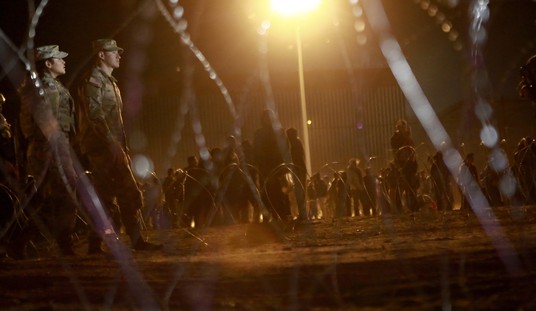“Detroit is responsible for its own demise,” Rich Lowry writes at NRO:
The city undertook a controlled experiment in what happens if you are governed by a toxic combination of Great Society big spenders, race hustlers, crooks, public-sector unions, and ineffectual reformers. It spent and misgoverned itself into the ground. It tried to defy the axiom of the late economist Herb Stein that “if something cannot go on forever, it will stop.” Detroit’s bout of self-destruction lasted for a few decades, and now may finally stop only when there is little left to destroy.
The city was at the pioneering edge of urban liberalism and discovered that all the social spending in the world doesn’t deliver order, family stability, education, economic dynamism, or effective governance. In the hands of Detroit’s rotten political class, it proved inimical to all of those things.
The city’s downfall started long before anyone imagined that the Big Three would ever be anything but overwhelmingly dominant. Hardly anyone had heard of Toyota in 1967, when riots ripped the city and a long crime wave began that made it unlivable. According to Henry Payne of the Detroit News, the murder rate climbed from 13 per 100,000 residents in 1966 to 51 per 100,000 by 1976.
It was the city’s dysfunction that made it unappealing to the auto companies rather than the diminished state of the auto companies that made the city dysfunctional. The city’s mayor for 20 years, Coleman Young, was an ethically challenged black nationalist who hated the suburbs. Under Young, journalist Zev Chafets writes, Detroit had “all the trappings of a third-world city — the showcase projects, an external enemy, and the cult of personality.” And this was in the good old days of the 1970s and 1980s.
By this point, Detroit had already reached terminal velocity on its own. GM had nothing to do with the city council promising benefits to retirees that it couldn’t possibly pay. Chrysler didn’t disgracefully mismanage city agencies. Ford didn’t disastrously degrade the city’s human capital.
If “Suicide by Government” was the goal, shouldn’t Cloward-Piven advocates be taking a victory lap over what they’ve accomplished there? Back in 2010, Ron Radosh noted that “the two socialist intellectuals developed a new so-called ‘crisis strategy’ — that of trying to use the existing welfare system to create chaos that would weaken the corporate capitalist state and eventually foment revolution:”
As Stanley Kurtz explains in Radical-in-Chief: “the idea was to flood state and local welfare systems with more applicants than they could possibly afford to carry. Cloward and Piven believed that this ‘break the bank’ strategy would force President [Lyndon B.] Johnson and a liberal Democratic Congress to bail out overburdened state welfare systems with a federally guaranteed annual income.” This experience of activism by the poor would create a new anti-capitalist sentiment, and would stoke the poors’ “sense of entitlement and rage.” Later, the group’s mission would be carried on by ACORN, whose leaders endorsed and built upon Cloward and Piven’s strategy.
The idea was to consciously create a fiscal crisis of the state. ACORN’s chief strategist, Peter Dreier, explained this in an article, “The Case for Transitional Reform,” which appeared in the journal Social Policy in February 1979. Dreier called for injecting “unmanageable strains into the capitalist system, strains that precipitate an economic and/or political crisis,” producing a “revolution of rising entitlements” that “cannot be abandoned without undermining the legitimacy of the capitalist class.” Once a “fiscal crisis in the public sector” occurred, the movement could push for creation of “socialist norms” being advanced as the only possible solution.
A few decades have passed since this strategy was first announced. They had great hopes that when Bill Clinton became president, they could implement their strategy. But the Clinton administration — once seen potentially by the Left as a vehicle for fulfillment of its dreams — worked with Republicans in Clinton’s second term to pass meaningful and successful welfare reform. This was precisely the opposite of what the Left wanted and hoped for.
Now, as President Barack Obama is beginning the mid-point of his first and possibly only term in office, the Left is again trying to advance a new form of the old strategy. And the author of the new program is none other than Frances Fox Piven, the co-author with her late husband of the original 1966 article. Clearly, Piven looks back fondly with memories of what NWRO did in the 1970s. The New York Times reported on their tactics on September 22, 1970:
There have been sit-ins in legislative chambers, including a United States Senate committee hearing, mass demonstrations of several thousand welfare recipients, school boycotts, picket lines, mounted police, tear gas, arrests — and, on occasion, rock-throwing, smashed glass doors, overturned desks, scattered papers and ripped-out phones.
My friend Sol Stern, now with City Journal and the Manhattan Institute, explained how successful they were:
The flooding succeeded beyond Wiley’s wildest dreams. From 1965 to 1974, the number of households on welfare soared from 4.3 million to 10.8 million, despite mostly flush economic times. By the early 1970s, one person was on the welfare rolls in New York City for every two working in the city’s private economy.
And speaking of which, in the Sunday New York Post, Kyle Smith flashed back to the surprisingly horrid condition of New York just twenty years ago:
If you think the Travis Bickle era was the high point for the Gotham mayhem industry, you’re wrong. The fourth-worst year for murders in New York City was 1993, with 1,960 (Nos. 1-3 are 1990-1992, the other three years of the David Dinkins administration).
In the first half of this year, in a city that is home to about 20% more people, there were 156.
It wasn’t so long ago that things were completely crazy, when guests at cocktail parties chatted about strategies for dealing with muggers (it was widely believed that you should always carry what we called ”mugger money” so as not to anger your attackers). Those who were brave enough to park cars on city streets made sure to remove the stereos when they parked, then place “No radio, nothing valuable in car” signs on their dashboards. If you fell asleep on a subway train, you awoke with an X neatly cut over your pocket and your wallet gone.
In his forthcoming memoir, Dinkins blames “racism, pure and simple,” not residents fed up by a city out of control, for his narrow 1993 defeat by Rudy Giuliani.
Now it seems likely that we’re going to elect another conventional liberal mayor, for the first time in two decades. As Dinkins did during his successful 1989 campaign, most of the rival Democratic candidates for mayor are playing for votes by trying to turn citizens against the police (though a recent poll found that Commissioner Ray Kelly, who is rumored to be the next head of Homeland Security in DC, enjoys an approval rating of 75%, including more than 60% among blacks).
The 20 years of the Giuliani-Bloomberg era have been a pleasant vacation from the decades-long decline that preceded it. Today we joke about soda bans instead of how to react to armed robbers. But soon New York may be back doing what it does best: Being Crazytown, USA.
New York received a two-decade long reprieve from its descent into madness, beginning in the late 1960s. If Mayor Weiner and Comptroller Spitzer decide to vacate the crime-fighting techniques pioneered by Rudy Giuliani and kept more or less in place by his successor, perhaps they two will unconsciously be looking to replicate Detroit on the Hudson.
Update: In June, Michael Barone wrote:
[Coleman] Young complained about white flight, but that’s not much of a problem any more. Hardy urbanites are trying to reclaim neighborhoods around downtown and Wayne State University for their hip form of civilization and may succeed. Now blacks are fleeing. Detroit’s black population peaked at 777,000 in 1990; it leveled off to 775,000 in 2000 and plunged to 590,000 in 2010. Blacks with decent jobs and steady habits have been moving to the suburbs or back to their grandparents’ South, and those who remain tend to be the people with no good alternative and no hope. Those who have visited both Detroit and Hiroshima will have trouble guessing which country won that war.
Didn’t somebody else make that last observation two and a half years ago? As Kate of Canada’s Small Dead Animals blog likes to say, “But Glenn Beck is the Crazy One.”
Oh, and speaking of “Suicide by Government,” this time on a national scale, in the Washington Examiner, Byron York asks, “Are Republicans fooling themselves about Obamacare?”
Obamacare could face even bigger problems. The most serious is the so-called “death spiral,” which could occur if too few young, healthy people sign up for coverage, dramatically raising the cost of covering everyone else.
But collapse of its own weight? The administration’s insurance against that is the billions of dollars that will start flowing out of Washington Jan. 1. Once that happens, Republicans will likely stop talking about Obamacare’s collapse and will instead start searching for ways to limit the harm done to millions of Americans.
What could go wrong?









Join the conversation as a VIP Member